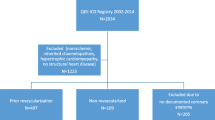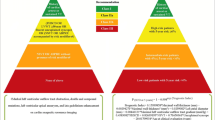Abstract
Background
Myocardial bridging (MB) and hypertrophic cardiomyopathy (HCM) are associated with the risk of fatal ventricular arrhythmias (VAs). The goal of the study was to determine the relationship between MB and fatal VAs in HCM patients with implantable cardiac defibrillators (ICD).
Methods
A total of 108 HCM patients (mean age: 46.6 ± 13.6 years; male: 73) were enrolled in this retrospective study. All patients underwent transthoracic echocardiography and coronary computed tomography angiography. Fatal VAs including sustained ventricular tachycardia and ventricular fibrillation were documented in ICD records.
Results
There were documented fatal VAs in 29 (26.8%) patients during a mean follow-up time of 71.3 ± 30.9 months. Compared with the other groups, the fatal VA group had a higher incidence of the following: presence of MB (82.8 vs. 38%, p < 0.001), deep MB (62.1 vs. 6.3%, p < 0.001), very deep MB (24.1 vs. 0%, p < 0.001), long MB (65.5 vs. 11.4%, p < 0.001), presence of > 1 MB (17.2 vs. 0%, p = 0.001), and MB of the left anterior descending artery (79.3 vs. 17.7%, p < 0.001) . Sudden cardiac death (SCD) risk score (hazard ratio: 1.194; 95% CI: 1.071–1.330; p = 0.001) and presence of MB (hazard ratio: 3.815; 95% CI: 1.41–10.284; p = 0.008) were found to be independent predictors of fatal VAs in HCM patients.
Conclusions
The current data suggest that the SCD risk score and presence of MB were independent risk factors for fatal VAs in patients with HCM. In addition to conventional risk factors, the coronary anatomical course can provide clinicians with valuable information when assessing the risk of fatal VAs in HCM patients.
Zusammenfassung
Hintergrund
Myokardiales Bridging (MB) und hypertrophe Kardiomyopathie (HCM) gehen einher mit dem Risiko letaler ventrikulärer Arrhythmien (VA). Ziel der vorliegenden Studie war es, den Zusammenhang zwischen MB und letalen VA bei Patienten mit HCM und implantierbaren kardialen Defibrillatoren (ICD) zu untersuchen.
Methoden
In diese retrospektive Studie wurden insgesamt 108 HCM-Patienten (Durchschnittsalter: 46,6 ± 13,6 Jahre; männlich: 73) einbezogen. Bei allen Patienten wurde eine transthorakale Echokardiographie und eine koronare Computertomographie-Angiographie durchgeführt. Letale VA einschließlich anhaltender ventrikulärer Tachykardie und Kammerflimmern wurden per ICD dokumentiert.
Ergebnisse
Während einer durchschnittlichen Nachbeobachtungsdauer von 71,3 ± 30,9 Monaten gab es bei 29 (26,8%) Patienten dokumentierte letale VA. Im Vergleich zu anderen Gruppen wies die Gruppe mit letalen VA eine höhere Inzidenz für folgende Parameter auf: Vorliegen von MB (82,8 vs. 38%; p < 0,001), tiefes MB (62,1 vs. 6,3%; p < 0,001), sehr tiefes MB (24,1 vs. 0%; p < 0,001), langes MB (65,5 vs. 11,4%; p < 0,001), Vorliegen von > 1 MB (17,2 vs. 0%; p = 0,001) und MB des Ramus interventricularis anterior (79,3 vs. 17,7%; p < 0,001). Der Risikoscore für plötzlichen Herztod (Hazard Ratio: 1,194; 95%-Konfidenzintervall, 95%-KI: 1,071–1,330; p = 0,001) und Vorliegen von MB (Hazard Ratio: 3,815; 95%-KI: 1,41–10,284; p = 0,008) stellten sich als unabhängige Prädiktoren letaler VA bei HCM-Patienten heraus.
Schlussfolgerung
Die aktuellen Daten deuten darauf hin, dass der Risikoscore für plötzlichen Herztod und das Vorliegen von MB unabhängige Risikofaktoren für letale VA bei Patienten mit HCM sind. Zusammen mit konventionellen Risikofaktoren bietet der anatomische Verlauf der Koronarien den behandelnden Ärzten wertvolle Informationen, wenn es um die Beurteilung des Risikos letaler VA bei HCM-Patienten geht.


Similar content being viewed by others
Abbreviations
- HCM:
-
Hypertrophic cardiomyopathy
- ICD:
-
Implantable cardiac defibrillators
- MB:
-
Myocardial bridging
- SCD:
-
Sudden cardiac death
- VA:
-
Ventricular arrhythmia
References
Sternheim D, Power DA, Samtani R et al (2021) Myocardial bridging: diagnosis, functional assessment, and management: JACC state-of-the-art review. J Am Coll Cardiol 78:2196–2212
Olivotto I, Cecchi F, Yacoub MH (2009) Myocardial bridging and sudden death in hypertrophic cardiomyopathy: salome drops another veil. Eur Heart J 30:1549–1550
Gori F, Basso C, Thiene G (2000) Myocardial infarction in a patient with hypertrophic cardiomyopathy. N Engl J Med 342:593–594
Yetman AT, McCrindle BW, MacDonald C, Freedom RM, Gow R (1998) Myocardial bridging in children with hypertrophic cardiomyopath—a risk factor for sudden death. N Engl J Med 339:1201–1209
Nie C, Zhu C, Yang Q, Xiao M, Meng Y, Wang S (2021) Myocardial bridging of the left anterior descending coronary artery as a risk factor for atrial fibrillation in patients with hypertrophic obstructive cardiomyopathy: a matched case-control study. BMC Cardiovasc Disord 21:382
Elliott PM, Anastasakis A, Borger MA et al (2014) 2014 ESC guidelines on diagnosis and management of hypertrophic cardiomyopathy: the task force for the diagnosis and management of hypertrophic cardiomyopathy of the European society of cardiology (ESC). Eur Heart J 35:2733–2779
van der Velde N, Huurman R, Yamasaki Y et al (2020) Frequency and significance of coronary artery disease and myocardial bridging in patients with hypertrophic cardiomyopathy. Am J Cardiol 125:1404–1412
Maron BJ (2002) Hypertrophic cardiomyopathy: a systematic review. JAMA 287:1308–1320
Konen E, Goitein O, Sternik L et al (2007) The prevalence and anatomical patterns of intramuscular coronary arteries: a coronary computed tomography angiographic study. J Am Coll Cardiol 49:587–593
Leipsic J, Abbara S, Achenbach S et al (2014) SCCT guidelines for the interpretation and reporting of coronary CT angiography: a report of the society of cardiovascular computed tomography guidelines committee. J Cardiovasc Comput Tomogr 8:342–358
Geske JB, Ommen SR, Gersh BJ (2018) Hypertrophic cardiomyopathy: clinical update. JACC Heart Fail 6:364–375
Williams B, Mancia G, Spiering W et al (2018) ESC scientific document group. 2018 ESC/ESH guidelines for the management of arterial hypertension. Eur Heart J 39:3021–3104
McDonagh TA, Metra M, Adamo M et al (2021) ESC scientific document group. 2021 ESC guidelines for the diagnosis and treatment of acute and chronic heart failure. Eur Heart J 42:3599–3726
Mach F, Baigent C, Catapano AL et al (2020) ESC scientific document group. 2019 ESC/EAS guidelines for the management of dyslipidaemias: lipid modification to reduce cardiovascular risk. Eur Heart J 41:111–188
McDonagh TA, Metra M, Adamo M et al (2021) 2021 ESC guidelines for the diagnosis and treatment of acute and chronic heart failure. Eur Heart J 42:3599–3726
Anderson J, Glynn LG (2011) Definition of chronic kidney disease and measurement of kidney function in original research papers: a review of the literature. Nephrol Dial Transplant 26:2793–2798
Mark DG, Huang J, Chettipally U, Kene MV, Anderson ML, Hess EP et al (2018) Performance of coronary risk scores among patients with chest pain in the emergency department. J Am Coll Cardiol 71:606–616
O’Mahony C, Jichi F, Pavlou M, Monserrat L, Anastasakis A, Rapezzi C, Biagini E et al (2014) Hypertrophic cardiomyopathy outcomes investigators. A novel clinical risk prediction model for sudden cardiac death in hypertrophic cardiomyopathy (HCM risk-SCD). Eur Heart J 35:2010–2020
Agatston AS, Janowitz WR, Hildner FJ et al (1990) Quantification of coronary artery calcium using ultrafast computed tomography. J Am Coll Cardiol 15:827–832
Maron BJ, Maron MS (2013) Hypertrophic cardiomyopathy. Lancet 381:242–255
Tower-Rader A, Kramer CM, Neubauer S, Nagueh SF, Desai MY (2020) Multimodality imaging in hypertrophic cardiomyopathy for risk stratification. Circ Cardiovasc Imaging 13:e9026
Ramchand J, Fava AM, Chetrit M, Desai MY (2020) Advanced imaging for risk stratification of sudden death in hypertrophic cardiomyopathy. Heart 106:793–801
Wang W, Lian Z, Rowin EJ et al (2017) Prognostic implications of nonsustained ventricular tachycardia in high-risk patients with hypertrophic cardiomyopathy. Circ Arrhythm Electrophysiol 10:e4604
Raphael CE, Cooper R, Parker KH, Collinson J, Vassiliou V, Pennell DJ et al (2016) Mechanisms of myocardial ischemia in hypertrophic cardiomyopathy: insights from wave intensity analysis and magnetic resonance. J Am Coll Cardiol 68:1651–1660
Chan RH, Maron BJ, Olivotto I et al (2014) Prognostic value of quantitative contrast-enhanced cardiovascular magnetic resonance for the evaluation of sudden death risk in patients with hypertrophic cardiomyopathy. Circulation 130:484–495
Geiringer E (1951) The mural coronary. Am Heart J 41:359–368
Möhlenkamp S, Hort W, Ge J, Erbel R (2002) Update on myocardial bridging. Circulation 106:2616–2622
Lazoura O, Kanavou T, Vassiou K, Gkiokas S, Fezoulidis IV (2010) Myocardial bridging evaluated with 128-multi detector computed tomography coronary angiography. Surg Radiol Anat 32:45–50
Hwang JH, Ko SM, Roh HG, Song MG, Shin JK, Chee HK et al (2010) Myocardial bridging of the left anterior descending coronary artery: depiction rate and morphologic features by dual-source CT coronary angiography. Korean J Radiol 11:514–521
Nishikii-Tachibana M, Pargaonkar VS, Schnittger I et al (2018) Myocardial bridging is associated with exercise-induced ventricular arrhythmia and increases in QT dispersion. Ann Noninvasive Electrocardiol 23:e12492
Cay S, Oztürk S, Cihan G, Kisacik HL, Korkmaz S (2006) Angiographic prevalence of myocardial bridging. Anadolu Kardiyol Derg 6:9–12
Murtaza G, Mukherjee D, Gharacholou SM et al (2020) An updated review on myocardial bridging. Cardiovasc Revasc Med 21:1169–1179
Feld H, Guadanino V, Hollander G et al (1991) Exercise-induced ventricular tachycardia in association with a myocardial bridge. Chest 99:1295–1296
Kurath-Koller S, Sallmon H, Scherr D et al (2020) Wearable cardioverter-defibrillator as bridging to ICD in pediatric hypertrophic cardiomyopathy with myocardial bridging—a case report. BMC Pediatr 20:207
Juillière Y, Berder V, Suty-Selton C et al (1995) Isolated myocardial bridges with angiographic milking of the left anterior descending coronary artery: a long-term follow-up study. Am Heart J 129:663–665
Cecchi F, Olivotto I, Gistri R et al (2003) Coronary microvascular dysfunction and prognosis in hypertrophic cardiomyopathy. N Engl J Med 349:1027–1035
Hostiuc S, Rusu MC, Hostiuc M, Negoi RI, Negoi I (2017) Cardiovascular consequences of myocardial bridging: a meta-analysis and meta-regression. Sci Rep 7:14644
Bruce C, Ubhi N, McKeegan P, Sanders K (2023) Systematic review and meta-analysis of cardiovascular consequences of myocardial bridging in hypertrophic cardiomyopathy. Am J Cardiol 188:110–119
Funding
The author(s) received no financial support for the research, authorship, and/or publication of this article.
Author information
Authors and Affiliations
Corresponding author
Ethics declarations
Conflict of interest
A. Güner, S. Atmaca, İ. Balaban, İ. Türkmen, D. Çeneli, A. Türkvatan, E. Öner, Ö. Sürgit, A. Güler, F. Uzun, G. Babür Güler, S. Kahraman, S. Pala, N. Havan, M. Yıldız and M. Ertürk declare that they have no competing interests.
For this article no studies with human participants or animals were performed by any of the authors. All studies mentioned were in accordance with the ethical standards indicated in each case.
Rights and permissions
About this article
Cite this article
Güner, A., Atmaca, S., Balaban, İ. et al. Relationship between myocardial bridging and fatal ventricular arrhythmias in patients with hypertrophic cardiomyopathy: the HCM-MB study. Herz 48, 399–407 (2023). https://doi.org/10.1007/s00059-023-05171-9
Received:
Revised:
Accepted:
Published:
Issue Date:
DOI: https://doi.org/10.1007/s00059-023-05171-9
Keywords
- Hypertrophic cardiomyopathy
- Myocardial bridging
- Ventricular arrhythmia
- Coronary computed tomography angiography




